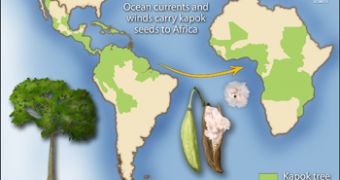The kapok tree is going to solve a mystery that has puzzled the biologists for a long time: the similarity between African and South American rainforests.
The two continents split 130 millions years ago; still, their forests are too similar, and it seems that 96 million years ago, they were still exchanging flora.
A team led by evolutionary ecologist Christopher Dick at the University of Michigan showed that kapok, and perhaps other rainforest trees, entered Africa after the continents split, apparently through the seeds that traveled across the (back then narrow) Atlantic ocean. "This research provides vital information for one of the most highly threatened areas of the planet, tropical rainforests," said Sam Scheiner, program director in National Science Foundation's Division of Environmental Biology, which funded the research. "In order to plan for and mitigate global climate change, we need to understand the history of life on Earth through studies like this one."
"Oceanic dispersal links the world's rainforests and this study is one of the first to catch that process in action at the species level. Although single seeds are very unlikely to survive an oceanic voyage and then successfully become established elsewhere, such improbable events become probable over 10 to 15 million years." said Dick.
The kapok tree (Ceiba pentandra) is a rain forest species that grows taller than a 16-story building (70 m or 240 ft), its canopy poking above the forest. Its most famous tree relative is the baobab. It is widely cultivated in South America and Southeastern Asia for its wood and cottony fibers.
Its flowers produce over 50 gallons of nectar per tree in a season, attracting bats that travel as far as 12 miles (20 km) between trees, transporting pollen in the process.
When the seed capsules (which look like a pod) ripen, they release the seeds wrapped in fluffy fibers that are used to stuff pillows and mattresses (exactly like in the case of cotton, to which the tree is related). The seeds - about the size of those belonging to a sunflower - float down rivers, on whose sides the colossal trees thrive.
Ceiba occurs naturally only in tropical America and Western Africa, divided by an over 2,848 km (1,770 mi) wide ocean.
Dicks' team concluded that the "voyage" by wind or ocean currents explains how the trees spread from South America to Africa, 96 millions years ago, when the Atlantic Ocean was narrower.
The team will check the role of the oceanic dispersal for other species, too, and for the entire plant communities. "This tree has become locally extinct in parts of the Peruvian Amazon as a result of overexploitation for plywood. It might be saved from widespread extinction by continuing to invade new land areas through oceanic dispersal.", Dick said.

 14 DAY TRIAL //
14 DAY TRIAL //